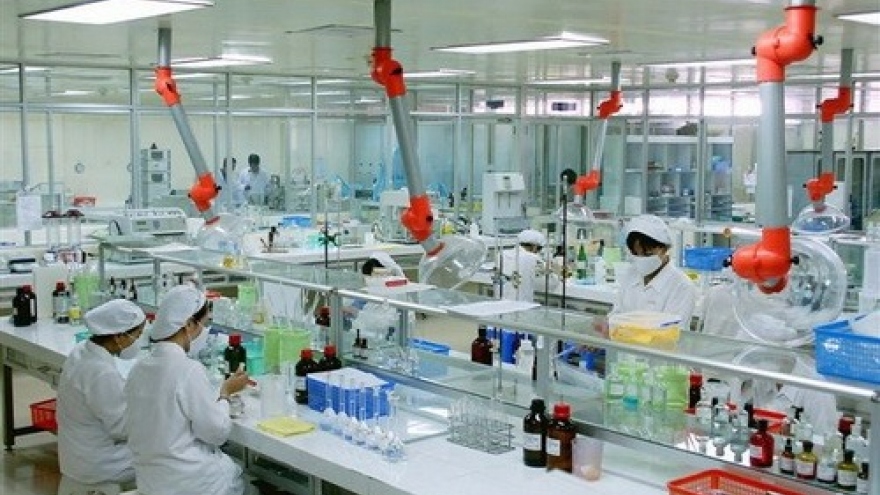Attractive life sciences seeking more headway
International pharmaceutical firms have created a focus towards the innovative life sciences sector in Vietnam in order to make long-term profit amid mounting competition, but the path to unlocking growth potential remains long.
 |
| Vietnam is becoming a magnet to foreign investors in the life sciences sector thanks to its strategy to raise healthcare access. |
Having been working as country president of AstraZeneca Vietnam for several months, Nitin Kapoor last week announced a partnership with Plan International Vietnam to bring the award-winning Young Health Programme (YHP), a global disease prevention initiative set up in 2010, to the country.
“We go beyond innovative medicines, and offer holistic healthcare solutions for patients. We work with regulatory authorities to seek viable solutions in balancing payments and ensuring the quality of medical care in Vietnam, while constantly bringing our innovation,” said Kapoor.
The YHP follows many life science programmes that AstraZeneca has been implementing in Vietnam for years, aiming to contribute to healthcare advancement for local patients while enabling the firm to make long-term and sustainable profits.
The YHP is being brought under a three-year programme to Vietnam, a country where common non-communicable diseases (NCDs) such as cancer, diabetes, heart disease and respiratory disease take a heavy toll on patients, caregivers and the healthcare system.
They are estimated to account for 73 per cent of the total deaths each year. The current target of the project is young people between 10 and 24 years of age in the Hai Ba Trung and Dong Anh districts of Hanoi.
The YHP targets young people as they make up a quarter of the country’s population. Moreover, Hanoi is a city with a growing middle-income class who are willing to spend more on pharmaceuticals and services to raise their health conditions.
Thus far, AstraZeneca has been conducting a number of life science programmes in Vietnam. Last year, they signed a pact with the Ministry of Health (MoH) to implement the Healthy Lung programme in the country.
In this, AstraZeneca targets people who suffer from chronic obstructive pulmonary disease (COPD), who account for about 4.2 per cent of the Vietnamese population.
Interest pushes ahead
According to the European Chamber of Commerce in Vietnam (EuroCham), the country continues to attract great interest from leading international businesses in the life sciences sector thanks to the nation’s strategy to increase healthcare access, affordability and quality for rural people.
The successful conclusion of international free trade agreements (FTAs), including the EU-Vietnam FTA and Vietnam’s regional integration through the ASEAN Economic Community (AEC), has put Vietnam in the spotlight.
Moreover, the country’s development of a legal framework also sends a positive signal to multinational corporations, and helps pave the way for a new era for Vietnam’s healthcare landscape.
Novartis Social Business is generating sustainable profit in Vietnam by supporting public health through novel and sustainable business models.
Its activities are rooted in local communities where it works with partners to provide affordable high-quality medicines against infectious and chronic diseases for low-incomers, while strengthening healthcare capacity.
For example, the Cung Song Khoe programme, a public-private partnership (PPP) between Novartis and Vietnam’s Services of Health, has been developed at the commune level since 2012. By providing health awareness, education, and affordable quality medicines, the initiative has so far reached more than 930,000 people.
In this way, Novartis produces value and makes a profit by selling public goods. “We provide social values through medicines,” Herald Nusser, head of NBS, told VIR.
Novartis is now working with the MoH on the possibilities of carrying out a PPP project in Vietnam in a move to increase its footprint in the country.
In similar moves Medtronic, one of the largest medical technology companies in the world, is offering a broad range of therapies across four areas: cardiac and vascular solutions, minimally-invasive therapies, restorative therapies, and diabetes care.
It views Vietnam, where locals spend around $2-3 billion on healthcare services abroad, as one of the most important emerging markets in the Asia Pacific region.
“We intend to launch specific programmes in which we will invest to improve overall healthcare in Vietnam,” said Omar Ishrak, CEO of Medtronic. “One such programme is STEMI, which is a method that helps save the lives of people suffering from heart attacks, in the proper manner.”
Spending over $2 billion on research and development activities annually, Medtronic is now cooperating with the Vietnam National Heart Institute to pilot the STEMI programme in the central province of Nghe An, and to train local doctors there.
Smart strategies
These latest moves by AstraZeneca, NSB, Medtronic and others prove how attractive the innovative life sciences sector in Vietnam is, and how smart their approach is amid stiffening competition from local and international drugmakers who are expanding local production to reap the incentives from the country’s plan to privilege domestically-produced pharmaceuticals.
“A government strategy to foster growth in innovative life sciences development would also set a strong foundation for PPPs which could develop over time and expand into areas building on other strategic priorities for Vietnam, such as ICT and e-health,” said EuroCham’s Pharma Group.
According to 2017 figures from health information provider IQVIA, 78 per cent of medicines by volume and 34 per cent of medicines by value are locally produced. In order to achieve the government’s objective of 80 per cent local production by 2020, it will be important to increase the value of products manufactured locally, and this is where innovative, high-quality, and high value-added medicines can play a key role.
Unlocking the potential
According to Minister of Health Nguyen Thi Kim Tien, there are a number of shortcomings, including underdeveloped infrastructure, lack of staff and finance, and low healthcare access among people in rural and remote areas. Therefore, the sector needs to carry out many similar programmes in the future, and seek international co-operation within these schemes.
According to industry insiders, Vietnam needs to focus on two key elements: a viable and sustainable legal framework to attract investment and enable partnership, and a continued strengthening of ethical standards to enhance trust and integrity.
“It needs to be a holistic approach, which combines a clear legal framework to establish operations and protect investors through all phases of development. Consequently, there is a need for a clear roadmap with different levels of incentives, to allow for the natural development of the industry,” said EuroCham’s Pharma Group.
The Republic of Ireland is an outstanding example of how to develop the innovative biopharmaceutical sector. Thirty years ago, the country was in a similar socio-economic situation to Vietnam, predominantly focused on agriculture. Today, the country is recognised as a best-practice in incentivising progress in innovative biopharmaceuticals, by having a clear roadmap for pharmaceutical sector development.
Consequently, pharmaceuticals currently generates over half of the country’s exports, contributing to making Ireland the largest net exporter of medicines globally with a total of $65 billion worth of exports annually. Furthermore, Ireland manufactures five of the world’s top 12 medicines and employs over 24,500 people, over half of which are third-level graduates, and another 24,500 people employed in provision services to the sector.
“Vietnam’s economic journey mirrors that of the Republic of Ireland, and hence understanding their progress, especially in the space of biopharmaceuticals, can provide important insights to policymakers and other stakeholders as they are work towards an accelerated economic roadmap,” EuroCham’s Pharma Group added.
With a clear roadmap, it would provide companies like AstraZeneca Vietnam with strong arguments to convince their global headquarters to invest in Vietnam, at a time when ASEAN member states are trying to position themselves as the regional manufacturing hub of the AEC.


